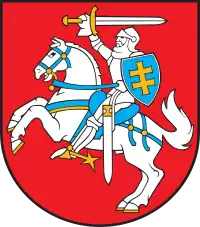| ||||||||||||||||||||||
I am for Lithuania's membership of the European Union. | ||||||||||||||||||||||
| Results | ||||||||||||||||||||||
|---|---|---|---|---|---|---|---|---|---|---|---|---|---|---|---|---|---|---|---|---|---|---|
| ||||||||||||||||||||||
 |
|---|
The 2003 Lithuanian European Union referendum took place from 10 May to 11 May 2003 to decide whether Lithuania should join the European Union (EU). Over 90% of those who voted supported membership and Lithuania joined the EU on 1 May 2004.
Background
Lithuania was invited to begin negotiations to join the EU in December 1999 at a European Council summit in Helsinki and was formally invited to join the EU in December 2002 at a summit in Copenhagen.
In June 2002 and February 2003 the Lithuanian Parliament amended Lithuania's laws on referendums. Previously, for a referendum to pass, 50% of the voters had to vote and over 50% of all eligible registered voters had to support the proposal. After the amendment only a simple majority of participants in favour was required for the referendum to pass, while still having the requirement for turnout to be over 50%. To help reach the turnout requirement, the voting hours were extended, postal voting was allowed for 11 days before the referendum, and a second voting day was added. In January 2003 parliament then set the date for EU referendum to be the 10–11 May and set the question for the vote.[1][2]
Referendum question
Lithuanian voters were asked to vote yes or no to the statement:
I am for Lithuania's membership of the European Union.[1]
Campaign
An information campaign on the European Union was begun in 2000 and involved the Elderships of Lithuania and the Catholic Church. Opinion polls, which at the end of 1999 had only 29% supporters of the EU, showed a steady rise in support in the years leading up to the referendum.[1]
Virtually all of Lithuania's major political parties supported membership of the EU and opinion polls as the date approached showed about 65% of voters would vote yes.[3] The President of Lithuania Rolandas Paksas, who once competed in aerobatics competitions, flew around Lithuania in his plane performing stunts to raise enthusiasm.[4] The campaign was very one-sided with only a poorly organised No campaign based on milk producers, Russian speakers and right wing nationalists.[1]
Turnout
The biggest concern for the yes campaign was whether turnout would reach the 50% required for the referendum to be valid.[3] After the first day of voting turnout was only 30% and both the President Paksas and Prime Minister Algirdas Mykolas Brazauskas appeared on TV to urge Lithuanians to vote.[5] Main reason for worry was that turnout might be as low as in Hungary just a month ago.
There was a surge in voting on the Sunday with many people voting after church services.[6] Lithuanian supermarkets also had a campaign on the second day of voting, offering cheaper beer, carbonated soft drink, chocolate and soap to those who showed they had voted.[1] In the end there were queues outside some voting booths and turnout was over 60%, safely over the required level.[7][8]
Results
| Choice | Votes | % | |
|---|---|---|---|
| For | 1,504,264 | 91.07 | |
| Against | 147,527 | 8.93 | |
| Total | 1,651,791 | 100.00 | |
| Valid votes | 1,651,791 | 98.77 | |
| Invalid/blank votes | 20,526 | 1.23 | |
| Total votes | 1,672,317 | 100.00 | |
| Registered voters/turnout | 2,638,886 | 63.37 | |
| Source: Nohlen & Stöver[9] | |||
Celebrations were held in Lithuania's capital Vilnius following the referendum. A concert was held near the Presidential palace, President Paksas addressed the crowd saying "Hello Europeans!" and the Prime Minister Algirdas Brazauskas and parliamentary speaker Artūras Paulauskas cut a referendum cake. The European Commission President Romano Prodi congratulated Lithuania on the referendum result.[10]
See also
References
- 1 2 3 4 5 "Referendum briefing No 8: The Lithuanian EU accession referendum 10–11 May 2003" (PDF). European Parties Elections and Referendums Network. Archived from the original (PDF) on 27 February 2008. Retrieved 2008-02-23.
- ↑ "Dauguma seimūnų pritaria narystės ES referendumo datai". DELFI. Archived from the original on 2021-06-05. Retrieved 2021-10-08.
- 1 2 "Turnout fear in Lithuania EU poll". CNN. 2003-05-11. Archived from the original on 2007-08-13. Retrieved 2008-02-23.
- ↑ "Lithuanians bury Soviet era in vote to join EU". The Daily Telegraph. London. 2003-05-12. Archived from the original on 2003-11-10. Retrieved 2008-02-23.
- ↑ "Press hails Lithuanian vote". BBC Online. 2003-05-12. Archived from the original on 2021-10-08. Retrieved 2008-02-23.
- ↑ "Lithuanians celebrate outcome of EU vote". USA Today. 2003-05-12. Archived from the original on 2021-10-08. Retrieved 2008-02-23.
- ↑ Boyes, Roger (2003-05-12). "Lithuania passes test of faith to vote in favour of joining European Union". The Times. London. Archived from the original on 2021-10-08. Retrieved 2008-02-23.
- ↑ http://www.krastas.lt/?data=2003-05-12&rub=1143711027&id=1146720611
- ↑ Nohlen, D & Stöver, P (2010) Elections in Europe: A data handbook, p1201 ISBN 978-3-8329-5609-7
- ↑ "EU welcomes Lithuania vote". BBC Online. 2003-05-12. Archived from the original on 2003-12-26. Retrieved 2008-02-23.